View in other NatureServe Network Field Guides
NatureServe
Montana
Utah
Wyoming
Idaho
Wisconsin
British Columbia
South Carolina
Yukon
California
New York
Giant Floater - Pyganodon grandis
Native Species
Global Rank:
G5
State Rank:
S4
Agency Status
USFWS:
USFS:
BLM:
External Links
General Description
This light-shelled (somewhat fragile) species was previously known as Anodonta grandis ("no tooth"-indicating it's lack of a tooth on it's hinge). Shell smooth, light yellow or yellowish green with rays visible in younger specimens, becoming dark green to brown in older shells and the nacre is white. Length to 10 inches, usually size about 5-6 inches (100 to 150 mm). Unlike the other native MT mussels, it can be found in smaller prairie rivers and in intermittent streams, if permanent pools are present, and prefers softer benthic sediments. Many fish species are known to serve as hosts for this species. All of these are warm water species and most of them were introduced into Montana. The known native hosts are the freshwater drum, Iowa darter, brook stickleback and possibly channel catfish. This species is likely expanding it's range in Montana with the introduction and range expansion of more of its host fish. These include carp, bullheads, golden shiner, centrarchids and yellow perch.
Diagnostic Characteristics
Thin, fragile, very much swollen and having a slight wing along the posterior hinge line; yellow to brown and nearly black. Beak sculpture consists of loops or folds that are raised into more or less conspicuous nodes or pustules. Young shells smooth and shining, old ones usually roughened and dark, frequently eroded. Length 165, height 92, breadth 60 mm. (La Rocque 1967)
Species Range
Montana Range
Range Descriptions

 Native
Native
Range Comments
Inside & outside of Montana this is a widespread and common species in the central and eastern parts of the continent. (Williams et al. 1993) and (La Rocque 1967) included Montana in it's range. This species is widely found in the Missouri, Little Missouri and Milk river systems of eastern MT. We have numerous records from the mainstem Missouri River from Fort Benton downstream to Kipp Bridge, upstream into the Musselshell and throughout numerous tributaries to the Milk River. This species was collected in the Little Missouri R. and tributaries to the Little Mo. near Wibaux, MT, but had not been reported for the Yellowstone River. Data cited by (Elrod 1902 and Henderson 1924). A giant floater shell was found in the Tongue River upstream of the Reservior in 2004 and in the Little Powder River in 2007, but live individuals were not found (origin of shell potentially dubious). In 2009, we documented records of the giant floater in the Yellowstone River Basin at 3 tributary sites (O’Fallon Creek, Little Porcupine Creek, Tongue River), but no evidence has been found of live specimens of this species in the Yellowstone River main stem.
Observations in Montana Natural Heritage Program Database
Number of Observations: 170
(Click on the following maps and charts to see full sized version)
Map Help and Descriptions
Relative Density
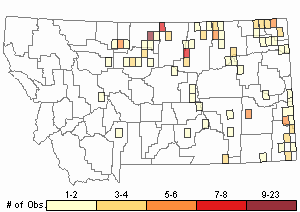
Recency
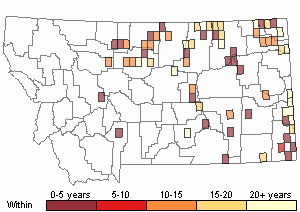
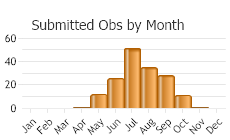
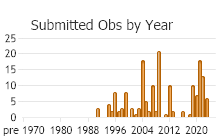
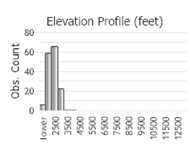 (Observations spanning multiple months or years are excluded from time charts)
(Observations spanning multiple months or years are excluded from time charts)
Migration
Adult freshwater mussels are mostly sedentary and spend their lives near the area where they first settled as juveniles. They will move short distances (a few meters) during spawning or if prompted by a stimulus such as a water disturbance nearby, exposure due to low water, or seasonal temperature changes. They may burrow into sediments (often doing so in the fall and emerging in the spring) or move away from the area horizontally.
May have dispersal through it's host fish, especially the carp.
Habitat
The species is generally found in quiet backwaters of slow streams, rivers or lakes and prefers soft bottoms consisting of sand, silt and mud. Although, we do have records of this species occurring in a gravel/cobble mix in some small streams. It is usually found in water from a few centimeters to 2 m deep. A large number of shell types exist which exhibit various modifications in form as a result of adaption to varying environmental conditions (La Rocque 1967). (Clarke 1981) reports the subspecies Anodonta grandis grandis [now Pyganodon grandis grandis] occurring in permanent ponds, rivers, and lakes of various sizes. It is most abundant on mud, but is found on all types of substrates.
Food Habits
Freshwater mussels are mostly filter-feeders, siphoning in floating particulate organic materials (small plant or animal) from the water column and straining out the particles and expel the strained water. Pedal feeding with the foot muscle has also been observed, mostly in juveniles and younger age-classes.
Reproductive Characteristics
(Clarke 1981) the subspecies Anodonta grandis grandis [now Pyganodon grandis grandis]: "The breeding season is reported to last from early August to the following April or May. Both dioecious (separate sexes) and monoecious (hermaphroditic) specimens occur. The glochidia are triangular-ovate, with spines, and measure from 0.31 to 0.36 mm long and 0.28 to 0.33 mm high. Native host fish species: Iowa darter, brook stickleback, channel catfish. Introduced host fish: carp, bullheads, centrarchids and yellow perch, green sunfish (Fuller 1974).
Stewardship Responsibility
Threats or Limiting Factors
Threats to freshwater mussels and their habitats include: Pollution, Diversion of rivers for irrigation, hydroelectric and water supply projects, Elimination of natural fish hosts, Eutropification due to agricultural runoff and urbanization. The giant floater is the most tolerant mussel in Montana to any of the above mentioned threats.
References
- Literature Cited AboveLegend:
 View Online Publication
View Online Publication Clarke, A.H. 1981. The freshwater molluscs of Canada. National Museum of Natural Sciences, National Museums of Canada, Ottawa. 446 pp.
Clarke, A.H. 1981. The freshwater molluscs of Canada. National Museum of Natural Sciences, National Museums of Canada, Ottawa. 446 pp. Elrod, M.J. 1902. A biological reconnoissance in the vicinity of Flathead Lake. Bulletin of the University of Montana Number, Biological Series 10(3):89-182.
Elrod, M.J. 1902. A biological reconnoissance in the vicinity of Flathead Lake. Bulletin of the University of Montana Number, Biological Series 10(3):89-182. Fuller, S.L.F. 1974. Clams and mussels (Mollusca: Bivalvia). Pp. 215-273 in: Hart, C.W., Jr. and S.L.F. Fuller. 1974. Pollution ecology of freshwater invertebrates. Academic Press, New York and London.
Fuller, S.L.F. 1974. Clams and mussels (Mollusca: Bivalvia). Pp. 215-273 in: Hart, C.W., Jr. and S.L.F. Fuller. 1974. Pollution ecology of freshwater invertebrates. Academic Press, New York and London. Henderson, J. 1924. Mollusca of Colorado, Utah, Montana, Idaho, and Wyoming. University of Colorado Studies 13(2):65-223.
Henderson, J. 1924. Mollusca of Colorado, Utah, Montana, Idaho, and Wyoming. University of Colorado Studies 13(2):65-223. La Rocque, A. 1967. Pleistocene Mollusca of Ohio. Department of Natural Resources, Division of Geological Survey Bulletin 62, Part 2. 113-365 + 8 plates.
La Rocque, A. 1967. Pleistocene Mollusca of Ohio. Department of Natural Resources, Division of Geological Survey Bulletin 62, Part 2. 113-365 + 8 plates. Williams, J.D., M.L. Warren Jr., K.S. Cummings, J.L. Harris, and R.J. Neves. 1993. Conservation status of freshwater mussels of the United States and Canada. Fisheries 18(9):6-22.
Williams, J.D., M.L. Warren Jr., K.S. Cummings, J.L. Harris, and R.J. Neves. 1993. Conservation status of freshwater mussels of the United States and Canada. Fisheries 18(9):6-22.
- Additional ReferencesLegend:
 View Online Publication
View Online Publication
Do you know of a citation we're missing? Hendricks, P., S. Lenard, D.M. Stagliano, and B.A. Maxell. 2013. Baseline nongame wildlife surveys on the Fort Peck Indian Reservation. Report to the Assiniboine and Sioux Tribes of the Fort Peck Indian Reservation. Montana Natural Heritage Program, Helena, MT. 83 p.
Hendricks, P., S. Lenard, D.M. Stagliano, and B.A. Maxell. 2013. Baseline nongame wildlife surveys on the Fort Peck Indian Reservation. Report to the Assiniboine and Sioux Tribes of the Fort Peck Indian Reservation. Montana Natural Heritage Program, Helena, MT. 83 p. Squyer, H. 1894. List of shells from the vicinity of Mingusville, Montana. The Nautilus 8:63-65.
Squyer, H. 1894. List of shells from the vicinity of Mingusville, Montana. The Nautilus 8:63-65.
- Web Search Engines for Articles on "Giant Floater"
- Additional Sources of Information Related to "Mussels / Clams"





